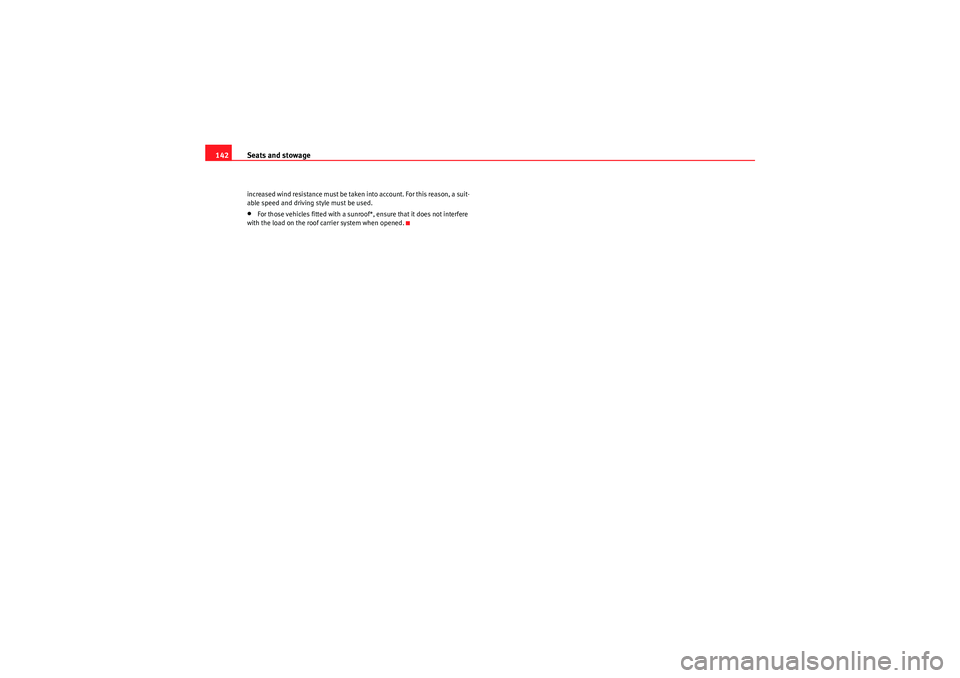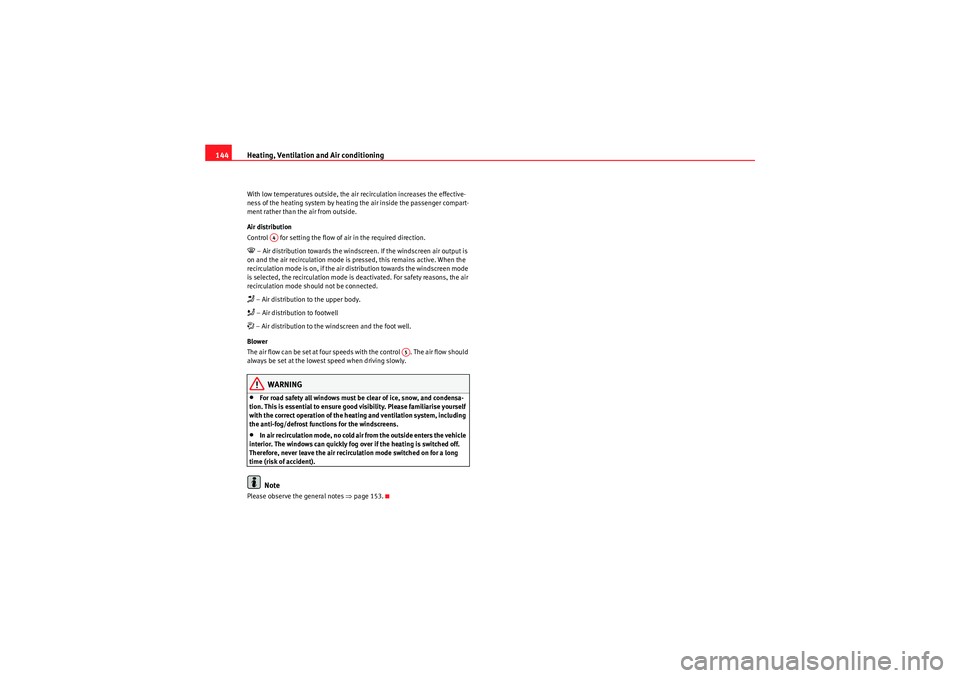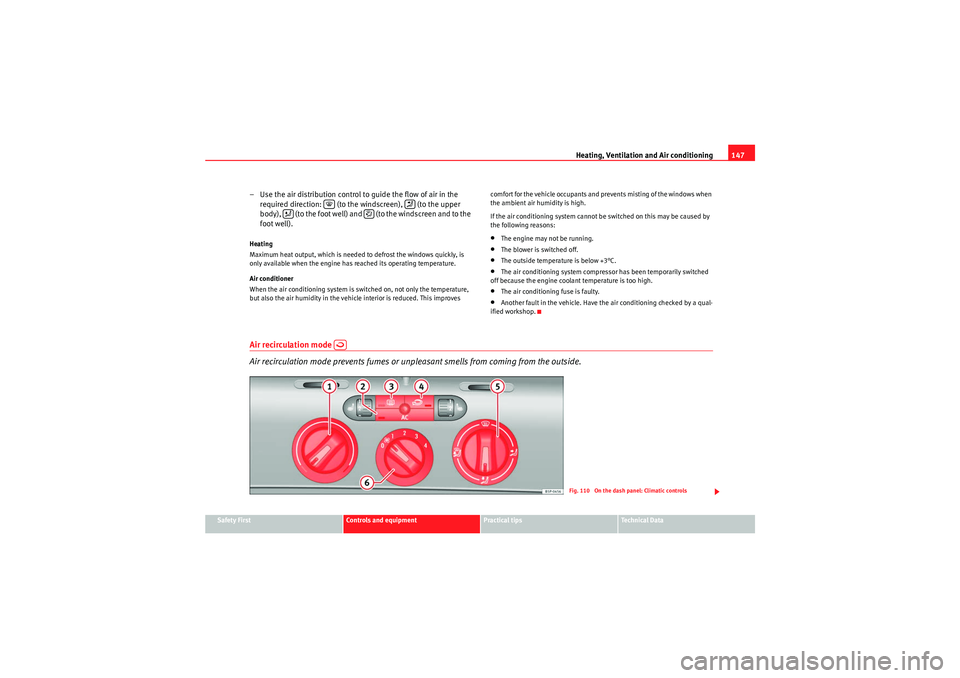Seat Leon 5D 2009 Owner's manual
Manufacturer: SEAT, Model Year: 2009, Model line: Leon 5D, Model: Seat Leon 5D 2009Pages: 304, PDF Size: 7.72 MB
Page 141 of 304

Seats and stowage139
Safety First
Controls and equipment
Practical tips
Technical Data
MEDIA-IN* connectorFor information concerning the use of this equipment, please see the Radio
handbook.
First-aid kit, warning triangle, fire
extinguisherWarning triangleThe emergency warning triangle can be fitted in the side lining of the boot.
Note
•The warning triangle is not part of the vehicle's standard equipment.First-aid kit and fire extinguisherThe first-aid kit* can be housed in a stowage box in the left side lining of the
luggage compartment.
Fig. 103 Opening
connector on central
consoleFig. 104 Connector on
the central console
Fig. 105 Housing for the
emergency warning
triangle in the boot
Leon_EN.book Seite 139 Dienstag, 8. September 2009 5:25 17
Page 142 of 304

Seats and stowage
140The fire extinguisher* is attached to the luggage compartment carpet by
Ve lcro.
Note
•The first-aid kit and the fire extinguisher are not part of the vehicle's
standard equipment.•The first aid kit must comply with legal requirements.•Observe the expiry date of the contents of the first aid kit. You should
purchase a new first-aid kit as soon as possible after the shelf-life date of the
first-aid kit has expired.•The fire extinguisher must comply with legal requirements.•Ensure that the fire extinguisher is fully functional. The fire extinguisher
should, therefore, be checked regularly. The sticker on the fire extinguisher
will inform you of the next date for checking.•Before acquiring accessories and emergency equipment see the instruc-
tions on ⇒page 206.BootStowing luggage
All luggage must be securely stowed.Please observe the following points to ensure the vehicle handles
well at all times:
– Distribute the load as evenly as possible.
– Place heavy objects as far forward in the luggage compartment
as possible. – Secure luggage in the luggage compartment with suitable straps
on the fastening rings.
WARNING
•Loose luggage and other loose items in the vehicle can cause serious
injuries.•Loose objects in the luggage compartment can suddenly move and
change the way the vehicle handles.•During sudden manoeuvres or accidents, loose objects in the
passenger compartment can be flung forward, injuring vehicle occupants.•Always store objects in the luggage compartment and secure with suit-
able straps. This is especially important for heavy objects.•When you transport heavy objects, always take in account that a
change in the centre of gravity can also cause changes in vehicle handling.•Please observe information on safe driving ⇒page 7, “Safe driving”.Caution
Hard objects on the shelf could chafe against the wires of the heating
element in the rear window and cause damage.
Note
The ventilation slots in front of the rear side windows must not be covered as
this would prevent stale air being extracted from the vehicle.
Leon_EN.book Seite 140 Dienstag, 8. September 2009 5:25 17
Page 143 of 304

Seats and stowage141
Safety First
Controls and equipment
Practical tips
Technical Data
Luggage compartment coverRemoving the cover
– Unhook the loops ⇒fig. 106 from housings
– Extract the cover from its slot, in its rest position and pull outwards.
WARNING
Do not place heavy or hard objects on the open stowage compartment,
because they will endanger the vehicle occupants in case of sudden
braking.
Caution
•Before closing the tailgate, ensure that the stowage compartment tray is
correctly fitted.
•An overloaded boot could mean that the rear stowage tray is not correctly
seated and it may be bent or damaged.•If the boot is overloaded, remove the tray.Note
•Ensure that, when placing items of clothing on the luggage compartment
cover, rear visibility is not reduced.Roof carrier*Please observe the following points if you intend to carry loads on the roof:•For safety reasons, only luggage racks and accessories approved by SEAT
should be used.•It is imperative to precisely follow the fitting instructions included for the
rack, taking special care when fitting the front bar in the holes designed for
this and the rear bar between the marks on the upper part of the rear door
frame while respecting the correct direction of travel indicated in the installa-
tion manual. Not following these instructions may damage the bodywork.•Pay special attention to the tightening torque of the attachment bolts and
check them following a short journey. If necessary, retighten the bolts and
check them at regular intervals.•Distribute the load evenly. A maximum load of 40 kg only is permitted for
each roof carrier system support bar, the load must be distributed evenly
along the entire length. However, the maximum load permitted for the entire
roof (including the support system) of 75 kg must not be exceeded nor should
the total weight of the vehicle be exceeded. See the chapter on “Technical
Data”.•When transporting heavy or large objects on the roof, any change in the
normal vehicle behaviour due to a change in the centre of gravity or an
Fig. 106 Stowage tray
AB
AA
Leon_EN.book Seite 141 Dienstag, 8. September 2009 5:25 17
Page 144 of 304

Seats and stowage
142increased wind resistance must be taken into account. For this reason, a suit-
able speed and driving style must be used.•For those vehicles fitted with a sunroof*, ensure that it does not interfere
with the load on the roof carrier system when opened.
Leon_EN.book Seite 142 Dienstag, 8. September 2009 5:25 17
Page 145 of 304

Heating, Ventilation and Air conditioning143
Safety First
Controls and equipment
Practical tips
Technical Data
Heating, Ventilation and Air conditioningHeatingControls and equipment– Using the controls ⇒fig. 107 and and the control you
can set the temperature, air distribution and the fan speed.
– To switch a function on or off, press the appropriate button or . When the function is activated, the display window in the
lower left of the button is lit.Te m p e r a t u r e
With the regulator the heating level is determined. The required tempera-
ture inside the vehicle cannot be lower than the ambient temperature. Maximum heat output, which is needed to defrost the windows quickly, is
only available when the engine has reached its operating temperature.
Rear window heater
This function will be switched off automatically approximately
20 minutes
after being switched on. It can also be switched off beforehand by pushing
the button.
Air recirculation mode
Air recirculation mode prevents strong odours in the outside air from
entering the vehicle interior, for example when passing through a tunnel or in
queuing traffic ⇒.
Fig. 107 On the dash panel there are the heating
controls
A1
A4
A5A2
A3
A1
A2
A3
Leon_EN.book Seite 143 Dienstag, 8. September 2009 5:25 17
Page 146 of 304

Heating, Ventilation and Air conditioning
144With low temperatures outside, the air recirculation increases the effective-
ness of the heating system by heating the air inside the passenger compart-
ment rather than the air from outside.
Air distribution
Control for setting the flow of air in the required direction. – Air distribution towards the windscreen. If the windscreen air output is
on and the air recirculation mode is pressed, this remains active. When the
recirculation mode is on, if the air distribution towards the windscreen mode
is selected, the recirculation mode is deactivated. For safety reasons, the air
recirculation mode should not be connected. – Air distribution to the upper body. – Air distribution to footwell – Air distribution to the windscreen and the foot well.
Blower
The air flow can be set at four speeds with the control . The air flow should
always be set at the lowest speed when driving slowly.
WARNING
•For road safety all windows must be clear of ice, snow, and condensa-
tion. This is essential to ensure good visibility. Please familiarise yourself
with the correct operation of the heating and ventilation system, including
the anti-fog/defrost functions for the windscreens.•In air recirculation mode, no cold air from the outside enters the vehicle
interior. The windows can quickly fog over if the heating is switched off.
Therefore, never leave the air recirculation mode switched on for a long
time (risk of accident).Note
Please observe the general notes ⇒page 153.
A4
A5
Leon_EN.book Seite 144 Dienstag, 8. September 2009 5:25 17
Page 147 of 304

Heating, Ventilation and Air conditioning145
Safety First
Controls and equipment
Practical tips
Technical Data
Climatic*Control switchesThe climatic or semi-automatic air conditioning system only works
when the engine is running and the turbine is switched on.
– Using the controls ⇒fig. 108 and and the control you
can set the temperature, air distribution and the turbine speed.
– To switch a function on or off, press the appropriate button , or . When the function is activated, the display window in
the lower corner of the button is lit.
Temperature selector ⇒page 146
Button – Heating, ventilation and air-conditioning system on/off
⇒ page 146 Button – Rear window heating. The heating will be switched off auto-
matically approximately
20 minutes after switching on. It can also be
switched off beforehand by pushing the button.
Button – Air recirculation mode ⇒page 147
Air distribution control ⇒page 146
Blower switch. There are four speed settings for the air flow. The air flow
should always be set at the lowest speed when driving slowly.
WARNING
For road safety all windows must be clear of ice, snow, and condensation.
This is essential to ensure good visibility. Please familiarise yourself with
the correct operation of the heating and ventilation system, including the
anti-fog/defrost functions for the windscreens.
Fig. 108 On the dash panel: Climatic controls
A1
A5
A6A2
A3
A4
A1A2
AC
A3
A4
A5A6
Leon_EN.book Seite 145 Dienstag, 8. September 2009 5:25 17
Page 148 of 304

Heating, Ventilation and Air conditioning
146
NotePlease observe the general notes ⇒page 153.Heating and cooling the interiorInterior heating
– Turn the temperature selector ⇒fig. 109 clockwise to select
the required temperature.
– Turn the blower switch to one of the settings 1-4.
– Set the air distribution control to the air flow configuration desired: (towards the windscreen), (towards the chest), (towards the footwell) and (towards the windscreen and
footwell areas). Interior cooling
– Switch on the air conditioning using the button
⇒page 145,
fig. 108 .
– Turn the temperature selector anti-clockwise until the desired cooling output is reached.
– Turn the blower switch to one of the settings 1-4.
Fig. 109 On the dash panel: Climatic controls
A1
AC
Leon_EN.book Seite 146 Dienstag, 8. September 2009 5:25 17
Page 149 of 304

Heating, Ventilation and Air conditioning147
Safety First
Controls and equipment
Practical tips
Technical Data
– Use the air distribution control to guide the flow of air in the
required direction: (to the windscreen), (to the upper
body), (to the foot well) and (to the windscreen and to the
foot well).Heating
Maximum heat output, which is needed to defrost the windows quickly, is
only available when the engine has reached its operating temperature.
Air conditioner
When the air conditioning system is switched on, not only the temperature,
but also the air humidity in the vehicle interior is reduced. This improves comfort for the vehicle occupants and prevents misting of the windows when
the ambient air humidity is high.
If the air conditioning system cannot be switched on this may be caused by
the following reasons:
•The engine may not be running.•The blower is switched off.•The outside temperature is below +3°C.•The air conditioning system compressor has been temporarily switched
off because the engine coolant temperature is too high.•The air conditioning fuse is faulty.•Another fault in the vehicle. Have the air conditioning checked by a qual-
ified workshop.
Air recirculation mode
Air recirculation mode prevents fumes or unpleasant smells from coming from the outside.
Fig. 110 On the dash panel: Climatic controls
Leon_EN.book Seite 147 Dienstag, 8. September 2009 5:25 17
Page 150 of 304

Heating, Ventilation and Air conditioning
148Air recirculation mode ⇒page 147, fig. 110 prevents strong odours in
the outside air from entering the vehicle interior, for example when passing
through a tunnel or in queuing traffic.
With low temperatures outside, the air recirculation increases the effective-
ness of the heating system by warming the air inside the passenger compart-
ment rather than the cold air from outside.
With high ambient temperatures, the air recirculation increases the effective-
ness of the air conditioning system by cooling the air inside the passenger
compartment rather than the ambient air.
If the windscreen air output is on and the air recirculation mode is pressed,
this remains active. When the recirculation mode is on, if the air distribution
towards the windscreen mode is selected, the recirculation mode is deacti-
vated. For safety reasons, the air recirculation mode should not be
connected.
WARNING
In air recirculation mode, no cold air from the outside enters the vehicle
interior. If the air conditioning system is switched off, the windows can
quickly mist over. Therefore, never leave the air recirculation mode
switched on for a long time (risk of accident).
Leon_EN.book Seite 148 Dienstag, 8. September 2009 5:25 17